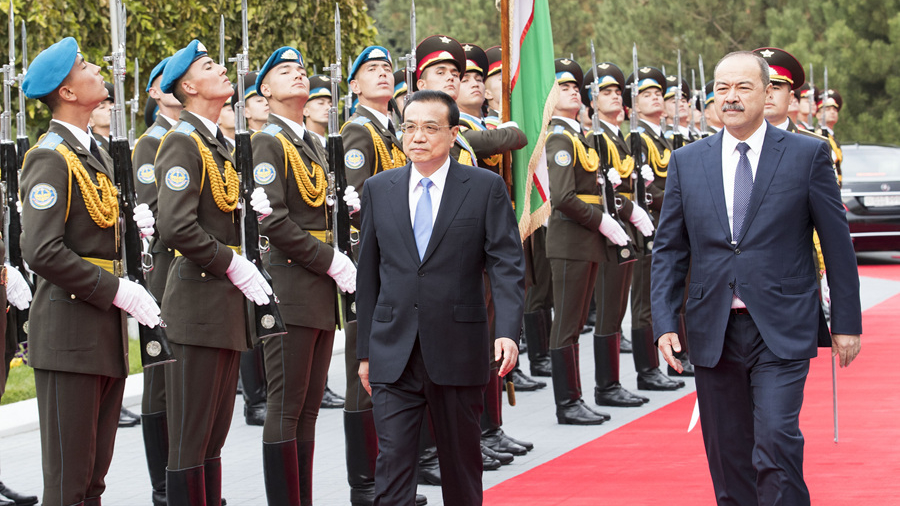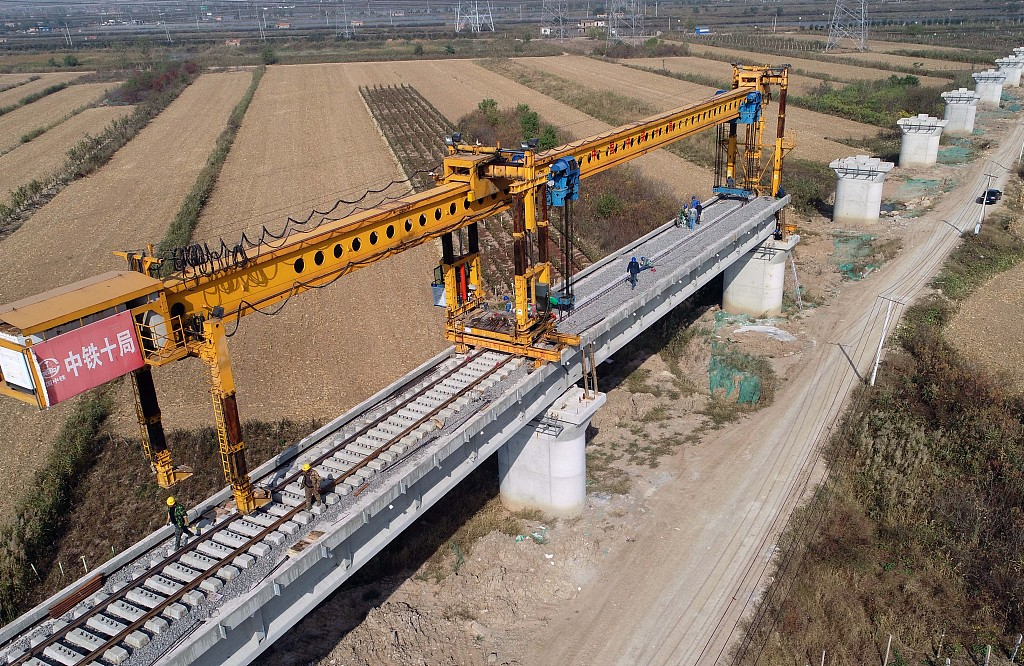
Chinese Premier Li Keqiang, accompanied by Uzbek Prime Minister Abdulla Aripov, inspects the guards of honor during a welcome ceremony in Tashkent, Uzbekistan, November 1, 2019. /Xinhua Photo
Chinese Premier Li Keqiang, accompanied by Uzbek Prime Minister Abdulla Aripov, inspects the guards of honor during a welcome ceremony in Tashkent, Uzbekistan, November 1, 2019. /Xinhua Photo
Editor's note: Cui Zheng, Associate Professor, Research Center for the Economies and Politics of Transitional Countries, Liaoning University. The article reflects the author's opinions, and not necessarily the views of CGTN.
On November 1, the 18th Meeting of the Council of Heads of Government of the Shanghai Cooperation Organization (SCO) member states in Tashkent, the capital city of Uzbekistan, started. Chinese Premier Li Keqiang is attending the event. At the meeting, he will exchange in-depth views with the leaders of the participating countries based on the consensus reached at the Bishkek Summit earlier this year in June.
Efforts will be made to create more synergies between the Belt and Road Initiative, regional cooperation initiatives and the development strategies of each country, to drive further practical cooperation among the member states and provide a stronger boost for the development and prosperity of all stakeholders.
Since the establishment of the SCO, economic and security cooperation and cultural exchanges have constituted the mainstay of this organization. The SCO reached many achievements in the areas of economy and trade. In 2018, the total trade volume among the member states reached 255 billion U.S. dollars, a year-on-year increase of 17.2 percent.
As of the end of April 2019, China's total investment in other SCO member states exceeded 87 billion U.S. dollars, and the total contract amount of China's construction projects in these countries reached 237.8 billion U.S. dollars. Several large-scale energy-related, mineral and industrial manufacturing projects have made headway.
In the meantime, cooperation mechanisms have adopted more innovative approaches. The establishment of local economic and trade cooperation demonstration zones has provided a new international cooperation platform for the coordination between the Belt and Road Initiative and the SCO, and a two-way opening-up paradigm with links between the domestic market and the global market over land and sea.
The way forward: enhance connectivity and promote long-term cooperation
The main task of the upcoming SCO Council of Heads of Government is to implement a joint solution for multilateral trade, economic and investment cooperation among the SCO member states. One important item on the agenda is to exchange views on the continuous pursuit of the Sustainable Development Goals till 2030 and better cooperation in transport, energy, industry, finance, agriculture, customs, telecommunications, and other areas.
One focus will be on deepening multilateral transport cooperation by establishing new and modernized international transport corridors. Specifically, more expressways will be designed, in conjunction with building multimodal logistics centers, to raise the transit potential of the SCO member states.
Another item high on the agenda is the signing of a new version of the 2035 Program of Multilateral Trade and Economic Cooperation among the SCO Member States. The document advocates for the adoption of modern innovation and green technologies on top of Phase I (2003-2020) achievements. In the run-up to 2030, the program will evolve under the framework of the SCO trade and investment rules to promote services and e-commerce and to drive the transformation of the national economy by streamlining the trade procedures.

Railway workers work along in a special railway project of the Shanghai Cooperation Organization international logistics park in Lianyungang, China, October 31, 2019. /VCG Photo
Railway workers work along in a special railway project of the Shanghai Cooperation Organization international logistics park in Lianyungang, China, October 31, 2019. /VCG Photo
An outlook on economic and trade cooperation: Opportunities and risks side by side
Deepening the economic and trade cooperation under the SCO framework is of positive significance to improving the cooperation mechanism of the SCO. Firstly, the SCO should increase the engagement of new member states within the organizational context. Since India and Pakistan became full members of the SCO in 2018, they have been through a crucial period of membership transition. India and Pakistan and other member states have shared long economic and trade relations.
Through the establishment of a new economic cooperation mechanism under the framework of the SCO, it is conducive to the "soft landing" of the identity transition of new member states, thus promoting broader and more practical multilateral security cooperation.
Secondly, economic cooperation will spill over to enhance the SCO's political influence. One of China's long-term visions for the SCO is to achieve regional economic integration, improve its surrounding environment and enhance its economic might, making it one of the regional organizations with global influence. Since the establishment of the SCO, not very much economic cooperation has taken place.
The misalignment of the attitudes of the SCO member states has directly affected the synergetic development within the SCO. By coordinating the top-level development strategies of the member states and their industrial planning centered on sustainable development, the SCO has improved the cooperation mechanism and strengthened political mutual trust among member states.
Outsiders have viewed the mutually beneficial "Shanghai Spirit" as a kind of "regionalism" based on the defined functions of globalization, which to a certain extent, helps to avoid the misunderstanding that the SCO is a geopolitical bloc.
Thirdly, there are challenges in economic and trade cooperation under the SCO framework. The biggest concern is external factors, such as global economic slowdown and trade protectionism. The SCO has many advantages: economic prowess, abundant natural resources, technology know-how, and investment and financial potential.
It is home to nearly half of the world's population, with a total annual output of more than 18 trillion U.S. dollars. It accounts for 20 percent of the global GDP, with an average national growth rate of five percent. The SCO member states advocate for the adoption of an open, transparent and non-discriminatory multilateral trade system in accordance with the rules of the World Trade Organization. However, the current instability facing the multilateral free trade market poses risks to the fulfillment of economic and trade cooperation within the organization.
Another sticky issue is the imbalance in trade and investment among the SCO member states. Most of the ongoing cooperation project funding is loaned out from China. Funding will become the main challenge hindering project implementation.
(If you want to contribute and have specific expertise, please contact us at opinions@cgtn.com.)